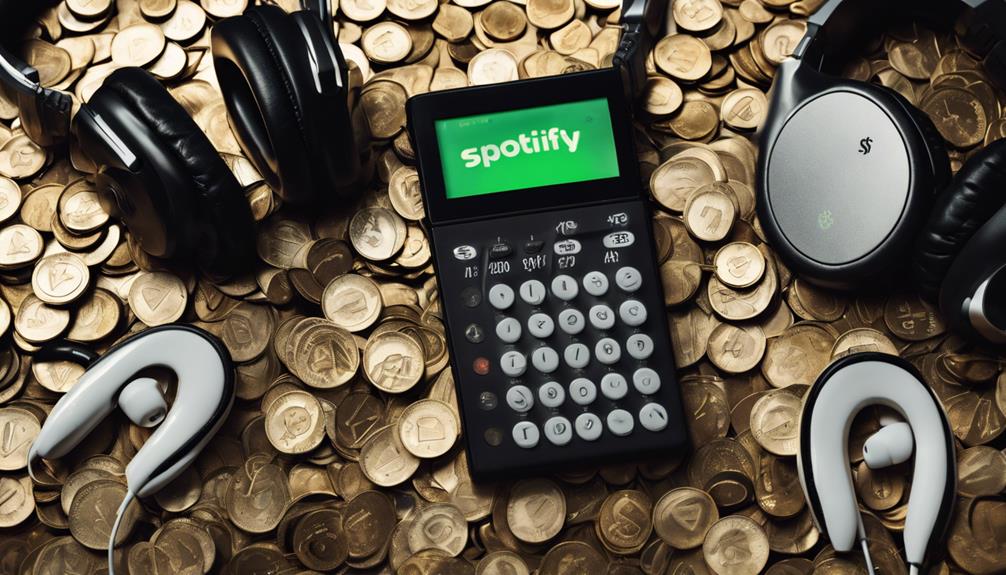
How much is 1,000 plays on Spotify?
On Spotify, you’re likely to earn around $3 to $5 for 1,000 plays. Their per-stream rate typically ranges from $0.003 to $0.005. Your final earnings depend on factors like the listener’s subscription type, your agreement with rights holders, and regional play rates. Beware that Spotify’s payout rate per stream is lower compared to platforms like Apple Music or Tidal. By understanding their payout system, you can strategize to boost your revenues. Stay tuned to explore how you can maximize your profit from Spotify plays.
Key Takeaways
- Spotify’s payout for 1,000 plays ranges between $3 and $5, based on the per stream rate of $0.003 to $0.005.
- The actual earning depends on the percentage of total streams and the type of listeners (free or premium).
- Royalties are distributed by the label or distributor, which can impact the final earnings from 1,000 plays.
- Earnings from 1,000 plays can be influenced by regional payment rates and contractual agreements with rights holders.
- Tax implications might reduce the take-home pay from 1,000 Spotify plays.
Understanding Spotify’s Payment Model

To fully grasp how much 1,000 plays on Spotify could earn you, it’s crucial to first understand Spotify’s unique payment model. Spotify operates on a freemium model, offering both free and premium Spotify subscriptions. Whether you’re dealing with a free or premium user, the number of plays on your track influences your artist royalties.
Spotify doesn’t pay per play. Instead, they distribute royalties based on the percentage of total streams your song garners. Consider it a pool of money collected from Spotify subscriptions and advertising. Your slice of this pool is directly proportional to your share of total song plays. For instance, if your song gets 0.005% of all plays, you’ll get 0.005% of the available royalties.
Now you might be thinking, ‘What about premium plays?’ Well, they’re weighted more heavily. The payment from a premium user’s stream is noticeably more than that from a free user. So, the type of listener also matters.
In a nutshell, your earning potential on Spotify isn’t just about how many plays you get. It’s a complex blend of total plays, listener type, and global royalty pool. This intricate model is what determines your earnings for 1,000 plays on Spotify.
Factors Affecting Spotify Payouts
You may be wondering what impacts your payout from Spotify, and it’s important to realize that several factors come into play. First and foremost, regional disparities have a substantial effect on your earnings. Spotify’s payment rates fluctuate across different regions due to factors like currency value, market saturation, and listeners’ consumption habits.
For instance, a stream in the U.S may yield more earnings compared to one from a developing country, primarily due to economic disparities. Your track’s performance in high-paying regions, hence, can substantially influence your overall revenue.
Contractual agreements also play a vital role in determining your payout. You see, streaming services don’t pay artists directly. Instead, they distribute royalties to rights holders, typically record labels or distributors, who then pass on a portion to the artists. The percentage you receive is based on the terms of your contract, which can greatly vary.
Consequently, a favorable agreement could mean a higher payout per stream, even if it’s below the average rate.
Calculating Earnings From 1,000 Plays

Crunching the numbers to figure out your earnings from 1,000 plays on Spotify isn’t as straightforward as it might seem, given the numerous variables involved. It’s not simply a matter of multiplying plays by a fixed rate.
To get a clear picture, consider these factors:
- Spotify’s Per Stream Rate: This typically ranges from $0.003 to $0.005 per stream. So, for 1,000 plays, you could be looking at $3 to $5.
- Royalty Distribution: Your earnings depend on your agreement with your label or distributor. They might take a cut before you see any money.
- Listener’s Subscription Type: Premium listeners generate more revenue than Free tier listeners. It’s important to know your audience.
- Tax Implications: Depending on your region, you may have to pay taxes on your Spotify income. This could considerably decrease your take-home pay.
Understanding these intricacies helps you make more informed decisions about your music distribution. Remember, Spotify is just a part of your overall music revenue strategy. Consider other income streams to supplement your earnings.
Innovation is key in the music industry, and understanding the financial dynamics of streaming platforms like Spotify is a step in the right direction.
Comparison With Other Streaming Platforms
When comparing Spotify’s payout rates with other platforms like Apple Music, Tidal, and Deezer, it’s important to understand its position in the music streaming landscape. Spotify, with its freemium model, often pays less per stream than its competitors. However, its sheer user base provides a significant advantage, leading to potentially larger overall payouts.
Platform differentiation plays a big role in streaming comparisons. Apple Music, for instance, doesn’t offer a free tier and typically pays more per stream, about $0.00735, compared to Spotify’s average of $0.00437. Tidal, known for high fidelity music and higher artist payouts, offers around $0.0125 per stream. Deezer’s pay rate floats around $0.0064.
These numbers don’t paint the whole picture, though. It’s also about volume. Spotify’s massive user base could mean more plays for your music, balancing lower per-stream payouts. Conversely, while Tidal pays more per stream, its smaller user base might result in fewer plays overall.
In the end, the platform you prioritize depends on your strategy. Are you after a wider audience or higher per-stream revenue? It’s a balance every artist must consider. Each platform offers unique opportunities and challenges in the streaming landscape.
Maximizing Your Spotify Revenue

Exploring the waters of Spotify revenue can prove to be a intricate task, but with the right strategies, it’s possible to maximize your earnings from the platform. If you’re looking to turn those 1,000 plays into a higher payday, it’s time to immerse into innovative approaches that can help boost your Spotify income.
Here are four key strategies:
- Playlist Curations: Expertly curated playlists can greatly increase your reach and therefore, your revenue. It’s not only about creating good music, but also about positioning it in the right playlists to attract the right audience.
- Subscriber Growth: Growing your follower base is crucial. Engage with your listeners, release new content consistently, and promote your Spotify profile across different platforms.
- Quality Over Quantity: While it’s important to be consistent, it’s equally vital to prioritize quality. High-quality tracks have better chances of being added to popular playlists, increasing your plays and revenue.
- Analytics: Use Spotify’s analytics to understand your audience better. Analyze their preferences, behaviors, and feedback to refine your music and marketing strategies.

